We were very lucky to be invited to house sit in Oundle, England. Not only were we staying in a lovely home in a neat little village, but the place was tricked out with everything one can imagine, including cable TV (in English), Wi-Fi and a BBQ grill. It also came with a great dog named Georgie and a classy white cat named Alfie. The two guys who owned the house (Lance and Adrian) have a gang of friends who immediately took us into their fold and made us feel right at home. It only made sense for us to have the gang over to the house for dinner and drinks.
We decided to offer our new English friends some good Southern hospitality in the form of slow smoked pork BBQ. For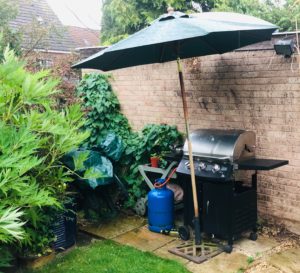 those of you who have not yet created this delicacy, the rest of this article is dedicated to a detailed explanation of how George does it. Note that before we sold everything and headed out to wander the world, George had a large pellet smoker and could smoke 50 pounds (22.7 kilos) of pork at a time. In England, we had fewer people to feed and a regular gas grill, some adjustments had to be made.
those of you who have not yet created this delicacy, the rest of this article is dedicated to a detailed explanation of how George does it. Note that before we sold everything and headed out to wander the world, George had a large pellet smoker and could smoke 50 pounds (22.7 kilos) of pork at a time. In England, we had fewer people to feed and a regular gas grill, some adjustments had to be made.
The first task is to figure out how much pork you need. In general, you should plan for a half to a third pound of cooked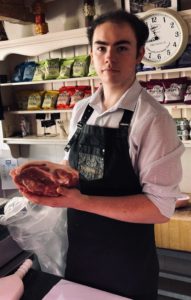 meat (150 – 200 grams) per person. Remember that the meat loses about 40% weight during the cooking process. In our case we were planning on feeding 7 people, but we also wanted some left over to freeze and share with our hosts when they returned home, so we were looking for a 5-7 pound butt. Once you know the size, then you need to find a piece of pork that is worthy of the time and effort that it takes to make this dish. After several stops, we found a local butcher in the village that said they could fix us up with a seven-pound (3.2 kilo) pork shoulder. It is worth noting that in the Southern part of America, we call this cut a pork butt, not at all sure why, as it does come from the shoulder area. The nice folks at Trendalls Butcher Shop in Oundle got us all fixed up.
meat (150 – 200 grams) per person. Remember that the meat loses about 40% weight during the cooking process. In our case we were planning on feeding 7 people, but we also wanted some left over to freeze and share with our hosts when they returned home, so we were looking for a 5-7 pound butt. Once you know the size, then you need to find a piece of pork that is worthy of the time and effort that it takes to make this dish. After several stops, we found a local butcher in the village that said they could fix us up with a seven-pound (3.2 kilo) pork shoulder. It is worth noting that in the Southern part of America, we call this cut a pork butt, not at all sure why, as it does come from the shoulder area. The nice folks at Trendalls Butcher Shop in Oundle got us all fixed up.
In most cases the butcher will cut the outer skin off the pork butt for you, if they do, ask 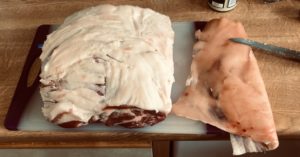 them to leave as much of the layer of fat (called a fat cap) between the skin and the meat as possible. The fat cap will help add moisture to the meat as it cooks down during the smoking process. Because we will be cooking this meat for many hours at a low temperature (low and slow) it is important to keep it from becoming dry. The fat cap will help, but there are also other steps we can take. This first is a process called brining, in essence, we will be soaking the meat in salt water. The salt helps the liquid be absorbed by the meat and it also helps add flavor
them to leave as much of the layer of fat (called a fat cap) between the skin and the meat as possible. The fat cap will help add moisture to the meat as it cooks down during the smoking process. Because we will be cooking this meat for many hours at a low temperature (low and slow) it is important to keep it from becoming dry. The fat cap will help, but there are also other steps we can take. This first is a process called brining, in essence, we will be soaking the meat in salt water. The salt helps the liquid be absorbed by the meat and it also helps add flavor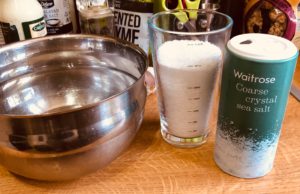 (double bonus). In a large container, mix about 2 cups of kosher salt and a cup of sugar into a gallon of water. Stir until all the solids are dissolved. Place the pork into a large plastic bag, pour the salt water over it, then work all of the air out of the bag and seal it shut with a strong twist tie. If you have enough room in the refrigerator you can put it there. I did not, so I put the whole thing in a small cooler with bag of ice to keep it cold. Brine the pork for between 24 and 30 hours.
(double bonus). In a large container, mix about 2 cups of kosher salt and a cup of sugar into a gallon of water. Stir until all the solids are dissolved. Place the pork into a large plastic bag, pour the salt water over it, then work all of the air out of the bag and seal it shut with a strong twist tie. If you have enough room in the refrigerator you can put it there. I did not, so I put the whole thing in a small cooler with bag of ice to keep it cold. Brine the pork for between 24 and 30 hours.
At some point while the pork is brining, you can mix up the rub you will be putting on the meat. There are a lot of different pre-mixed pork rubs on the market, but it is cheaper and better to make your own. Use the list of ingredients below to mix up enough rub for 1 pork butt, double if you are smoking two. Store it in a Ziplock bag, and save any leftover for the next time you cook any kind of pork.
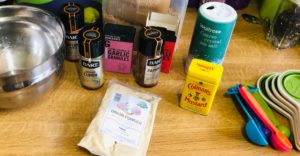 George’s Butt Rub
George’s Butt Rub
- 1/2 cup light brown sugar
- 1/4 cup sweet paprika (not smoked or hot)
- 2 tbsp salt
- 1 tbsp chili powder
- 1 tbsp onion powder
- 1 tbsp garlic powder
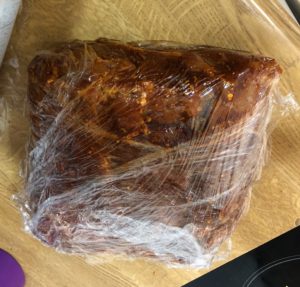
- 1 tbsp pepper
- 1 tbsp mustard powder
- 2 tsp cumin
- 1 tsp cayenne pepper
There are two other steps that can be taken care of in advance, one is to soak wood chips in a bowl of water overnight. We find that apple wood tends to taste the best when smoking pork. The second is to set up your grill. Regardless of whether you are using gas or charcoal, the objective is to keep the heat source on one side of the grill and he meat on the other (indirect heat). If possible, remove half of the grill rack on the heat side and leave the other half on the side where the meat will be. This will make it easy to place and refill a chip box and water pan. Place a metal pan on the grill floor below where the pork will be and fill it with water. This will not only help keep the inside of the smoker moist, but it will also catch a lot of the messy fat dripping from the pork, making clean up much easier later.
Once the meat is brined for 24 to 30 hours, take it out of the salt water, rinse it with cool clean water to remove excess salt and pat it dry. Next sprinkle the spice mixture (the butt rub) liberally over the pork and rub it in well. If you have time, it is best to do this in advance, then wrap the meat in cling film and let it refrigerate for 2 or more hours.
 On the morning of the day you will be smoking the meat (remember this
On the morning of the day you will be smoking the meat (remember this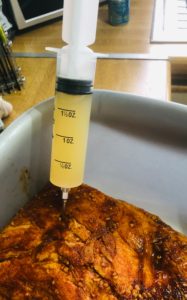 process can take up to 9 hours), fill the metal pan in the grill with water. Place a generous hand full of the soaked apple chips in the chip tray and either light the charcoal in a chimney or light one burner on the grill. In the photo below, you can see that we placed to the chip tray to the far left and we only used a single burner on the far-left side of the grill (indirect heat). Warm the grill so that the temperature of a gauge where the meat will be placed reads 220 degrees F (104 degrees C). Don’t trust the thermometer built into the top of the grill, it does not give you and accurate reading of what is happening at where the meat is. We recommend using an oven thermometer.
process can take up to 9 hours), fill the metal pan in the grill with water. Place a generous hand full of the soaked apple chips in the chip tray and either light the charcoal in a chimney or light one burner on the grill. In the photo below, you can see that we placed to the chip tray to the far left and we only used a single burner on the far-left side of the grill (indirect heat). Warm the grill so that the temperature of a gauge where the meat will be placed reads 220 degrees F (104 degrees C). Don’t trust the thermometer built into the top of the grill, it does not give you and accurate reading of what is happening at where the meat is. We recommend using an oven thermometer.
 While the grill is heating, make a mixture of half (50%) apple juice and half apple cider vinegar. You will need about 4 cups (1 liter) of this mixture to complete the day. Unwrap the pork butt and place it fat side up in a large pan. Using a large syringe, inject about 1.5 to 2 cups (about ½ liter) of the mixture into the pork butt. Out at the grill, take the pork out of the pan, and place it (still fat side up) on the grates away from the heat source.
While the grill is heating, make a mixture of half (50%) apple juice and half apple cider vinegar. You will need about 4 cups (1 liter) of this mixture to complete the day. Unwrap the pork butt and place it fat side up in a large pan. Using a large syringe, inject about 1.5 to 2 cups (about ½ liter) of the mixture into the pork butt. Out at the grill, take the pork out of the pan, and place it (still fat side up) on the grates away from the heat source.
Set a timer for 3 hours, find a good book: George re-read an old Travis McGee book (by John D. McDonald) and relax for a bit. For the first hour and a half just make sure your temperature stays around 220 F. If needed, add more wood chips to keep the smoke going. After 1.5 hours, mist the meat with a spray bottle full of your apple juice/cider mixture. Do this on the half hour until you have been smoking for 3 hours total. At the three hour mark, wrap the pork butt loosely in heavy duty aluminum foil, add half a cup of the apple juice/cider mixture and seal the foil tightly, this will allow the pork to “steam” inside the foil. For the next two hours the butt should be kept at a steady 225 degrees F, this can either be on the grill or inside in the oven. In BBQ cooking competitions, this step is known as “the cheat” or “the crutch”, it really helps keep the meat moist.
McGee book (by John D. McDonald) and relax for a bit. For the first hour and a half just make sure your temperature stays around 220 F. If needed, add more wood chips to keep the smoke going. After 1.5 hours, mist the meat with a spray bottle full of your apple juice/cider mixture. Do this on the half hour until you have been smoking for 3 hours total. At the three hour mark, wrap the pork butt loosely in heavy duty aluminum foil, add half a cup of the apple juice/cider mixture and seal the foil tightly, this will allow the pork to “steam” inside the foil. For the next two hours the butt should be kept at a steady 225 degrees F, this can either be on the grill or inside in the oven. In BBQ cooking competitions, this step is known as “the cheat” or “the crutch”, it really helps keep the meat moist.
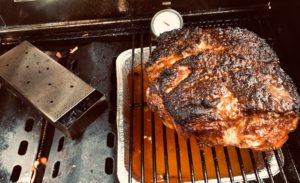 After two hours, unwrap the meat and put it back onto the rack on the grill. Continue to cook at 225 F and spray with your cider/vinegar mix every the half hour. After two hours, start checking the internal temperature of the meat when you spray. You are looking for an internal temperature of 169 F (76 degrees C) in all areas of the butt. Don’t worry if some areas get warmer, you will not overcook the meat. This final part of the cooking can take anywhere from 2 to 4 hours. Be patient, and do not be tempted to take the pork out before it reaches temp. If you do, it will make it nearly impossible to shred in the next step.
After two hours, unwrap the meat and put it back onto the rack on the grill. Continue to cook at 225 F and spray with your cider/vinegar mix every the half hour. After two hours, start checking the internal temperature of the meat when you spray. You are looking for an internal temperature of 169 F (76 degrees C) in all areas of the butt. Don’t worry if some areas get warmer, you will not overcook the meat. This final part of the cooking can take anywhere from 2 to 4 hours. Be patient, and do not be tempted to take the pork out before it reaches temp. If you do, it will make it nearly impossible to shred in the next step.
When you finally reach the desired temperature, remove the pork from the grill, place it on a pan and cover it with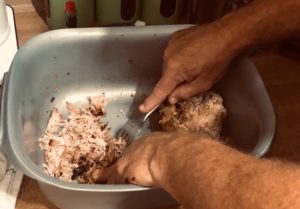 aluminum foil. Allow it to rest and cool for at least one hour (preferable two) before removing the bone and shredding the meat. The shredding (or pulling at it is called) is easiest with a pair of forks. If you are planning on smoking a lot of pork, you may want to invest in a set of “bear claws” to make the process of shredding faster and easier.
aluminum foil. Allow it to rest and cool for at least one hour (preferable two) before removing the bone and shredding the meat. The shredding (or pulling at it is called) is easiest with a pair of forks. If you are planning on smoking a lot of pork, you may want to invest in a set of “bear claws” to make the process of shredding faster and easier.
Once the meat is completely shredded, mix in a liberal amount of your favorite barbecue sauce (George likes Sweet Baby Ray’s)
Pro tip: most commercial BBQ sauce is way too thick to use and much too sweet.
Mix it down half and half with water for a better consistency and taste.
We have found that the pork tastes better if you refrigerate it overnight after it is shredded and mixed with sauce. Just pop it back in the oven for an hour at 250 F to reheat.
Last step: make up some side dishes, invite some friends over, pour a cold beer and bask in the glory of the compliments over your amazing pulled pork BBQ!



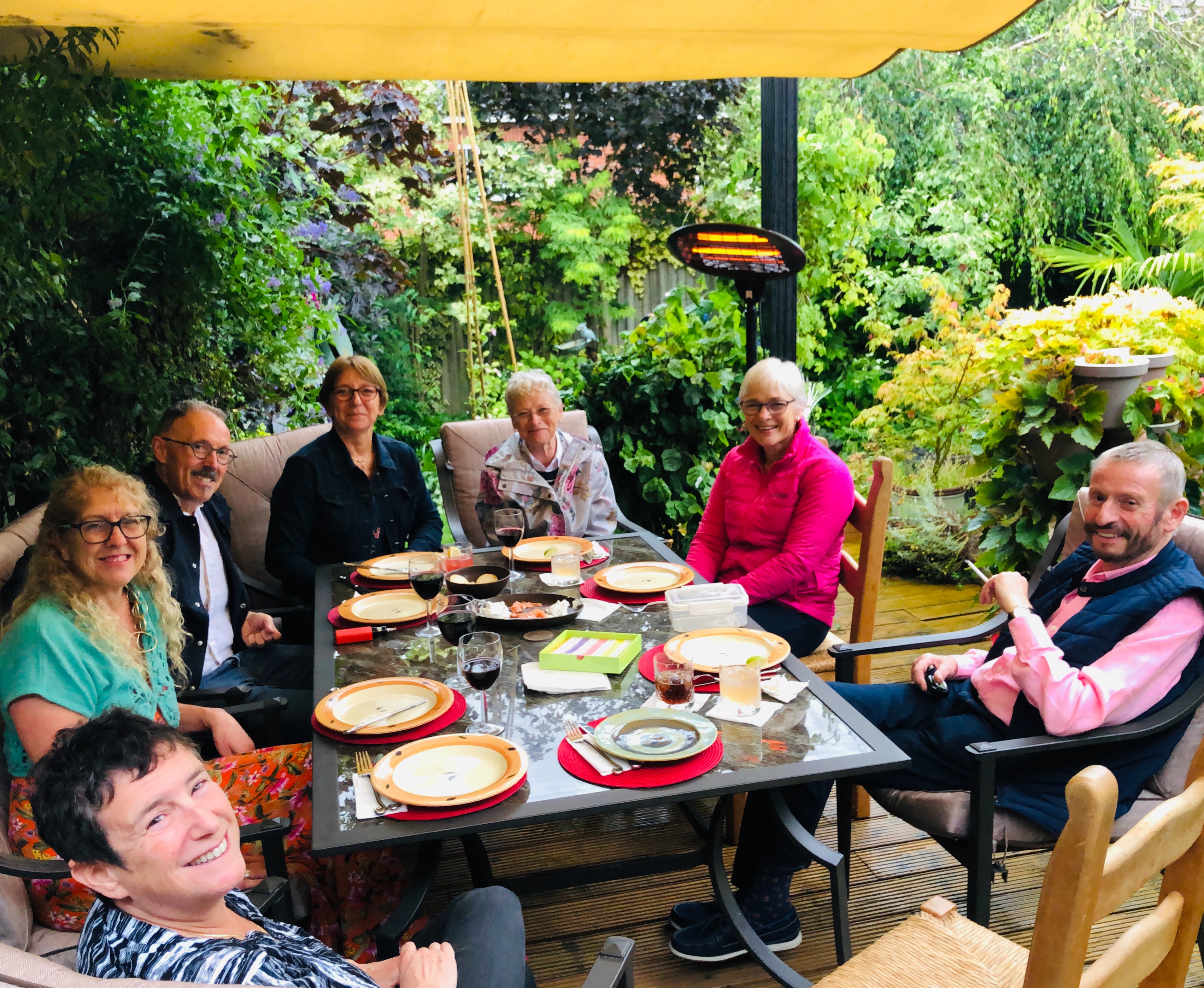
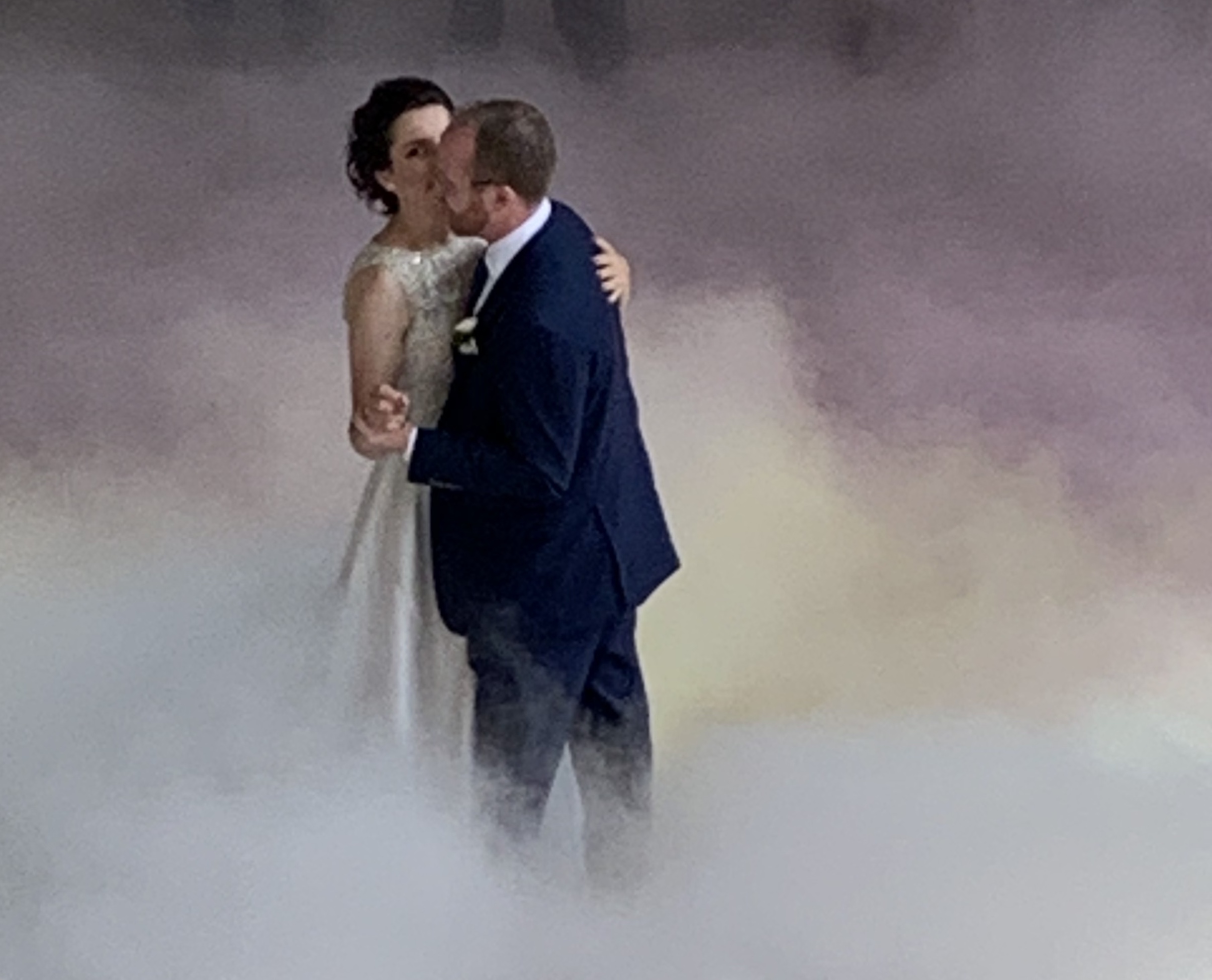
 meet up with Hansen Alumni (or Fellows as they are called), and we have also been lucky enough to have been invited to several weddings. We recently attended one wedding in Israel
meet up with Hansen Alumni (or Fellows as they are called), and we have also been lucky enough to have been invited to several weddings. We recently attended one wedding in Israel 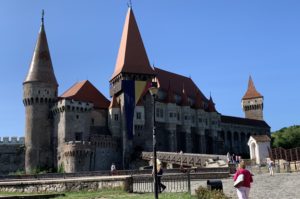 On the morning of first day of the wedding we were invited to tour
On the morning of first day of the wedding we were invited to tour  where Ramona’s grandmother lives. While waiting for the bride and groom we were treated to hand made doughnuts and cheese breads. We all crowded into a small country church, which was covered from floor to ceiling with amazing, hand painted bible scenes. When the couple and their chaperones arrived, we were all pleasantly surprised to see that they were dressed in traditional Romanian outfits. Ramona’s uncle, newly retired from his post as the villages’ priest, returned to the church to perform the engagement ceremony which was as filled with as much pageantry as most weddings.
where Ramona’s grandmother lives. While waiting for the bride and groom we were treated to hand made doughnuts and cheese breads. We all crowded into a small country church, which was covered from floor to ceiling with amazing, hand painted bible scenes. When the couple and their chaperones arrived, we were all pleasantly surprised to see that they were dressed in traditional Romanian outfits. Ramona’s uncle, newly retired from his post as the villages’ priest, returned to the church to perform the engagement ceremony which was as filled with as much pageantry as most weddings. With the engagement ceremony complete, everyone walked from the church through the village to Ramona’s grandmothers house for an amazing picnic lunch, full of hand-made food, home crafted brandies and liquor and a series of different meats grilled to perfection by Ramona’s dad, Vasile and his friends. We are told the party went on well into the night, we snuck off after several hours to greet the late travelers who had finally arrived at the hotel suite in Hunedoara.
With the engagement ceremony complete, everyone walked from the church through the village to Ramona’s grandmothers house for an amazing picnic lunch, full of hand-made food, home crafted brandies and liquor and a series of different meats grilled to perfection by Ramona’s dad, Vasile and his friends. We are told the party went on well into the night, we snuck off after several hours to greet the late travelers who had finally arrived at the hotel suite in Hunedoara.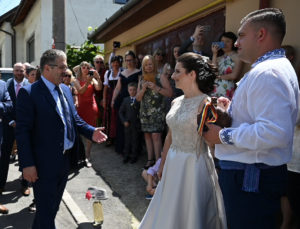 second day of the wedding was full on formal. I think everyone enjoyed getting spiffed up in suits and lovely dresses. The bus picked us up around noon and took us to the family home (where we had dinner two nights before). All the guest filled the street and generally stopped all traffic on the road in front of the house. Then we experienced another of the unique Romanian wedding traditions. The groom’s party, along with his male chaperone and his “spokesman” proceeded down the street, stopped at the house and knocked at the front door. The door was answered by the “spokesman” for the bride’s home. There is an initial exchange facilitated by drinking some very strong homemade liquor and then the formal negotiation. We will try to paraphrase the negotiation but please know that it was all in Romanian, some license may have been taken:
second day of the wedding was full on formal. I think everyone enjoyed getting spiffed up in suits and lovely dresses. The bus picked us up around noon and took us to the family home (where we had dinner two nights before). All the guest filled the street and generally stopped all traffic on the road in front of the house. Then we experienced another of the unique Romanian wedding traditions. The groom’s party, along with his male chaperone and his “spokesman” proceeded down the street, stopped at the house and knocked at the front door. The door was answered by the “spokesman” for the bride’s home. There is an initial exchange facilitated by drinking some very strong homemade liquor and then the formal negotiation. We will try to paraphrase the negotiation but please know that it was all in Romanian, some license may have been taken: The wedding itself took place in the Chapel of the Castle, despite the small size of the chapel, the ceremony was quite grand and included crowns for both the bride and groom. After the ceremony there were many photos on the grounds of the castle, and then onto the buses to head to the reception.
The wedding itself took place in the Chapel of the Castle, despite the small size of the chapel, the ceremony was quite grand and included crowns for both the bride and groom. After the ceremony there were many photos on the grounds of the castle, and then onto the buses to head to the reception.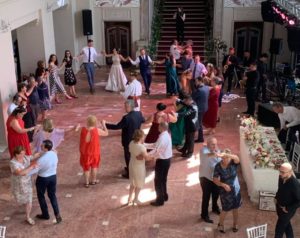 small dot of dry ice (the solid form of carbon dioxide) which made the champagne bubble and mist. This champagne was the first of many, many well thought out delights that added up to an amazing wedding reception. Other accents included a meal of five extremely robust courses, each was a treat all its’ own. In the hour or so break between each course there was traditional dancing, a photo booth, a clown and entertainment for the children, displays of sweets and nibbles and a full bar with a wide selection of mixed cocktails. After a cake cutting ceremony out in the
small dot of dry ice (the solid form of carbon dioxide) which made the champagne bubble and mist. This champagne was the first of many, many well thought out delights that added up to an amazing wedding reception. Other accents included a meal of five extremely robust courses, each was a treat all its’ own. In the hour or so break between each course there was traditional dancing, a photo booth, a clown and entertainment for the children, displays of sweets and nibbles and a full bar with a wide selection of mixed cocktails. After a cake cutting ceremony out in the courtyard, at almost midnight, the guests were treated to a private fireworks. All in all an amazing two days of celebrating the matrimony of Ramona and Jason.
courtyard, at almost midnight, the guests were treated to a private fireworks. All in all an amazing two days of celebrating the matrimony of Ramona and Jason. We would be remiss if we did not mention the gift bags that were given to each guest, one at arrival (full of all kinds of handy items and snacks) and one at the end of the event. Included in the bag that was handed out at the reception was a small bottle of brandy. It would be impossible for us to tell the story any better than the label on the bottle, so we have transcribed it below:
We would be remiss if we did not mention the gift bags that were given to each guest, one at arrival (full of all kinds of handy items and snacks) and one at the end of the event. Included in the bag that was handed out at the reception was a small bottle of brandy. It would be impossible for us to tell the story any better than the label on the bottle, so we have transcribed it below:
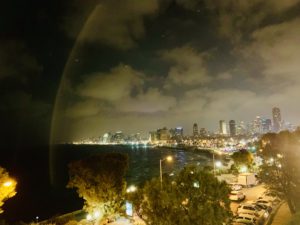 There is so much to tell about our trip to Israel it is hard to know where to start, so let’s just take things in the order that they happened so we don’t miss any important details.
There is so much to tell about our trip to Israel it is hard to know where to start, so let’s just take things in the order that they happened so we don’t miss any important details. The whole reason we were in Israel is for the wedding of one of Bonnie’s Hansen students. We wanted to see Shelly (and Brian) as soon as possible so we decided to meet them at a beach bar a short walk from our place. Shelly was nice enough bring a box of wedding clothes (a suit for George, dress for Bonnie and nice shoes). Thanks again Becky for packing these up and getting them to us, we will send them back after the second wedding! After meeting the wedding couple and several of their friends, we wandered back to our place, hit the local supermarket and settled in for a quiet evening of dinner and Netflix at our flat.
The whole reason we were in Israel is for the wedding of one of Bonnie’s Hansen students. We wanted to see Shelly (and Brian) as soon as possible so we decided to meet them at a beach bar a short walk from our place. Shelly was nice enough bring a box of wedding clothes (a suit for George, dress for Bonnie and nice shoes). Thanks again Becky for packing these up and getting them to us, we will send them back after the second wedding! After meeting the wedding couple and several of their friends, we wandered back to our place, hit the local supermarket and settled in for a quiet evening of dinner and Netflix at our flat.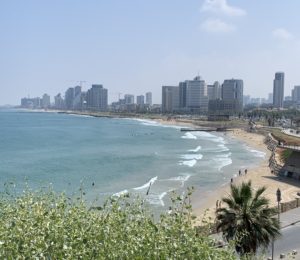
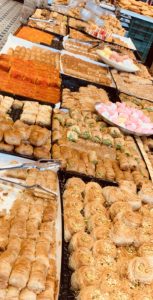 Sunday was the day for the big wedding. Since it was not until the evening, we started the day with a wander through Jaffa, this is a mostly Christian (with a lot of Muslim mixed in) section of Tel Aviv and the sidewalks are lined with shops selling food, sweets, clothing and everything in between.
Sunday was the day for the big wedding. Since it was not until the evening, we started the day with a wander through Jaffa, this is a mostly Christian (with a lot of Muslim mixed in) section of Tel Aviv and the sidewalks are lined with shops selling food, sweets, clothing and everything in between. make an effort to get invited to one. There is so much symbolism and pageantry to it. The bride and groom stand under a canopy, known as a chuppah (pronounced hoop-a); this represents the home that the couple will build together. The rabbi or cantor “sings” the most of the ceremony in Hebre
make an effort to get invited to one. There is so much symbolism and pageantry to it. The bride and groom stand under a canopy, known as a chuppah (pronounced hoop-a); this represents the home that the couple will build together. The rabbi or cantor “sings” the most of the ceremony in Hebre The day after the wedding the family was kind enough to invite us for a us for a guided tour of Jerusalem. Your religion (of lack thereof) doesn’t matter. There is enough history and culture here to overwhelm almost
The day after the wedding the family was kind enough to invite us for a us for a guided tour of Jerusalem. Your religion (of lack thereof) doesn’t matter. There is enough history and culture here to overwhelm almost 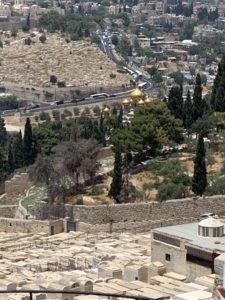 anyone. We started at the Mount of Olives and looked out over the old city. There is a huge graveyard just outside the walls of the city. The Jews believe that when the messiah comes to earth he will walk though of the gates into the old city and the dead everywhere will rise and follow him into eternal life. So religious folks spend a small fortune to be buried close to the gate with their feet facing the old city. This makes it some of the most expensive real estate in the world.
anyone. We started at the Mount of Olives and looked out over the old city. There is a huge graveyard just outside the walls of the city. The Jews believe that when the messiah comes to earth he will walk though of the gates into the old city and the dead everywhere will rise and follow him into eternal life. So religious folks spend a small fortune to be buried close to the gate with their feet facing the old city. This makes it some of the most expensive real estate in the world. Quarter with the exception of the Armenian area is open to the public. The Christian Quarter houses the Church of the
Quarter with the exception of the Armenian area is open to the public. The Christian Quarter houses the Church of the 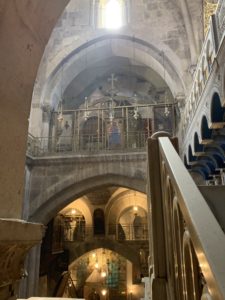 Holy Sepulcher and is built at the location of Calgary (or Golgatha) where Christians believe Jesus was crucified. It is possible to kneel at an alter at the top of the church, stick your hand through a hole in the floor and touch the top of the Calgary stone, and on the ground floor there is a slab of marble that is said to be the final resting place of Christ’s body. Deep inside the church you can see the tomb of Jesus along with many other sacred relics.
Holy Sepulcher and is built at the location of Calgary (or Golgatha) where Christians believe Jesus was crucified. It is possible to kneel at an alter at the top of the church, stick your hand through a hole in the floor and touch the top of the Calgary stone, and on the ground floor there is a slab of marble that is said to be the final resting place of Christ’s body. Deep inside the church you can see the tomb of Jesus along with many other sacred relics.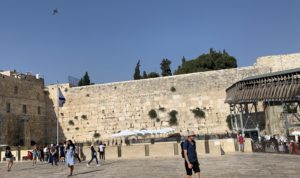 segregated so after a ceremonial washing of hands men and women approach the wall in separate areas. A common custom here is to write a prayer or wish onto a small scrap of paper and wedge the paper into the cracks of the wall.
segregated so after a ceremonial washing of hands men and women approach the wall in separate areas. A common custom here is to write a prayer or wish onto a small scrap of paper and wedge the paper into the cracks of the wall.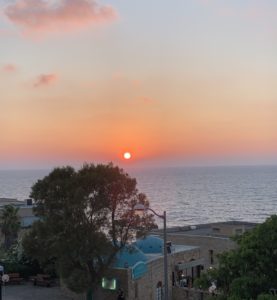 All too soon out trip to Tel Aviv was over, but we get to look forward to another wedding for another Hansen student…off to Romania!
All too soon out trip to Tel Aviv was over, but we get to look forward to another wedding for another Hansen student…off to Romania! We were lucky enough to visit friends and stay in their lovely new home in Brittany, their hospitality was amazing. Brittany is in Western France, it is bordered by the English Channel to the North and Normandy to the Northeast. It was especially poignant for us to be in this region on D-day, the anniversary of the day on which the allied forces landed in France to push back the Germans during World War II.
We were lucky enough to visit friends and stay in their lovely new home in Brittany, their hospitality was amazing. Brittany is in Western France, it is bordered by the English Channel to the North and Normandy to the Northeast. It was especially poignant for us to be in this region on D-day, the anniversary of the day on which the allied forces landed in France to push back the Germans during World War II.
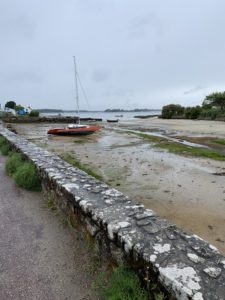

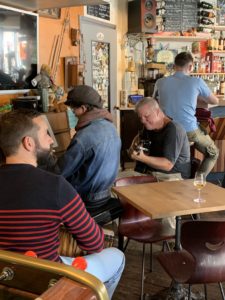
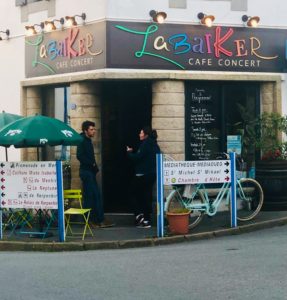 them and start playing or join into whatever music was happening. George had fun playing guitar with a local piano player, the only language they had in common was music, but they had lot of fun with it.
them and start playing or join into whatever music was happening. George had fun playing guitar with a local piano player, the only language they had in common was music, but they had lot of fun with it.
 Brittany, or Little Britain (as opposed to great Britain) was once an independent nation with its own Duke. We visited the
Brittany, or Little Britain (as opposed to great Britain) was once an independent nation with its own Duke. We visited the 